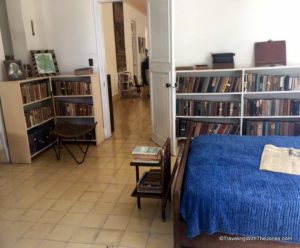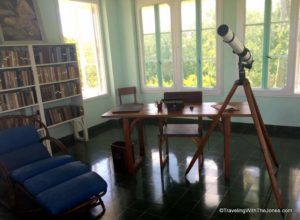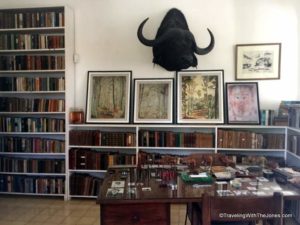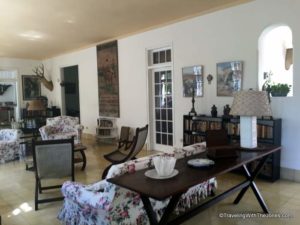VISITING ERNEST HEMINGWAY’S HABANERA FARM “LA VIGÍA”.
Ernest Hemingway: (July 21, 1899-Idaho, July 2, 1961) American writer whose work has had a notable influence both by the sobriety of his style and by the tragic elements and the portrait of an era he represents. Nobel Prize for Literature in 1954. He lived in Cuba for a period of twenty years.
The estate known as ‘La Vigia’, was Hemingway’s place of residence in Cuba since 1940. It is located in the town of San Francisco de Paula, fifteen kilometers from the center of Havana. It became a museum on July 21, 1962.
Finca Vigía is located in the town of San Francisco de Paula, in the capital municipality of San Miguel del Padrón. The numbers of US visitors have been increasing since 2015 with the process of reestablishing diplomatic relations between Cuba and the United States.

A. E. Hotchner, Hemingway’s friend, claims that while the author enjoyed view from the tower, and found it quiet place to read, he actually preferred to complete his serious writing on the typewriter on top of the bookcase in his bedroom in the main house.
The Finca “La Vigia” Vigia (which became a haven for Hemingway in 1939). Built in 1886 by a Spanish architect Miguel Pascual Baguer, Hemingway bought Finca Vigia in 1940 for a cost of $ 12,500. He would live there for two decades, until he bought a house near Ketchum, Idaho in 1959 to get out of the subtropical heat for part of the year. It is said that the house and grounds are virtually intact when Hemingway left them.
The truth is that everyone wants to know the paradise where Hemingway lived between 1939 and 1960. In the year 2016 was visited by 171,000 foreigners, including Germans, Canadians, Japanese, Americans and Chinese. Despite being quite far from the center of the capital, in 2016, some 9,000 Cubans came to the encounter with the life and work of the author of Farewell to arms. Until June 2017, 5,000 natural people from this Caribbean archipelago have reached the museum.
Finca Vigía has an area of 4.3 hectares and has a wooded area consisting of more than 200 mango trees, 150 palms, trees of species such as avocado, tamarind, mamoncillo, plum, sour orange and almond, among others.

It is easy to picture Hemingway being inspired to write For Whom the Bell Tolls and The Old Man and The Sea.
CREATION IN VIGÍA FINCA
In Hemingway’s personal room the Royal typewriter is still preserved. There the novelist’s creation flowed freely, and some of his great titles were born: ‘Through the river and among the trees’,’ Islands in the Gulf ‘,’ Garden of Eden ‘,’ Bloody summer ‘,’ For whom doblan Bells’, ‘The old man and the sea’ and ‘Paris was a party’.
Since the nineties of last century, the Museum has organized the International Colloquium Ernest Hemingway every two years, with researchers from all over the world who possess a very high intellectual level.
The ‘Finca Vigía’ Foundation, a small nonprofit organization based in Havana, has sailed in the banks of US-Cuba relations to create a binational project that has saved one of the most important monuments in the country. American literature. In doing so, the Foundation has built bridges between Cuban and US professionals, obtained support from both governments and provided training to Cuban conservationists.
Very well received by the national and foreign public would undoubtedly be another project that could not be implemented, at least in an institutional way. It is the Hemingway Route, to promote the visit to the Cuban sites preferred by the writer.
In this patrimonial route could not miss: the Fortress of Cojímar and the restaurant Las Terrazas in that fishing village of Havana, scene of the novel The old one and the sea; The Ambos Mundos Hotel, his first residence in Cuba between 1932-1939; La Bodeguita del Medio and El Floridita restaurant, on which Hemingway expressed with satisfaction: “My daiquirí in El Floridita, my mojito in La Bodeguita”. The route would conclude with a tour of the Finca Vigia Museum.
VISITANDO LA FINCA HABANERA DE ERNEST HEMINGWAY “LA VIGÍA”.
Ernest Hemingway: (Illinois, 21 de julio de 1899- Idaho, 2 de julio de 1961) Escritor estadounidense cuya obra ha ejercido una notable influencia tanto por la sobriedad de su estilo como por los elementos trágicos y el retrato de una época que representa. Premio Nobel de Literatura en 1954. Vivió en Cuba por un periodo de veinte años.
La Finca conocida como ‘La Vigía’, fue el lugar de residencia en Cuba de Hemingway desde el año 1940. Está ubicada en el poblado de San Francisco de Paula, a quince kilómetros del centro de La Habana. Se convirtió en museo el 21 de julio de 1962.
Finca Vigía se encuentra ubicada en la localidad de San Francisco de Paula, en el municipio capitalino de San Miguel del Padrón. Las cifras de visitantes norteamericanos han ido en aumento desde 2015 con el proceso de restablecimiento de las relaciones diplomáticas entre Cuba y los Estados Unidos.

Algunas de sus habitaciones en la Finca La Vigía está llena de libros y trofeos de sus cacerías internacionales.
La Finca “La Vigia” Vigia (que se convirtió en un refugio para Hemingway en 1939). Construido en 1886 por un arquitecto español Miguel Pascual Baguer, Hemingway compró Finca Vigia en 1940 por un costo de $ 12.500. Viviría allí durante dos décadas, hasta comprar una casa cerca de Ketchum, Idaho en 1959 para salir del calor subtropical durante parte del año. Se dice que la casa y los terrenos están prácticamente intactos cuando Hemingway los dejó.
Lo cierto es que todos quieren conocer el paraíso donde vivió Hemingway entre 1939 y 1960. En el pasado año 2016 la visitaron 171 000 extranjeros, entre alemanes, canadienses, japoneses, norteamericanos y chinos. Pese a encontrarse bastante alejada del centro de la capital, en 2016, unos 9 000 cubanos llegaron al encuentro con la vida y obra del autor de Adiós a las armas. Hasta el mes de junio de este 2017, 5 000 personas naturales de este archipiélago caribeño han llegado hasta el museo.
Finca Vigía posee una extensión de 4,3 hectáreas y cuenta con un área boscosa integrada por más de 200 matas de mango, 150 palmas, árboles de especies como aguacate, tamarindo, mamoncillo, ciruela, naranja agria y almendra, entre otras.
CREACIÓN EN FINCA VIGÍA
En la habitación personal de Hemingway aún se conserva la máquina de escribir marca Royal. Allí fluyó libre la creación del novelista y nacieron algunos de sus grandes títulos: ‘A través del río y entre los árboles’, ‘Islas en el Golfo’, ‘El jardín del Edén’, ‘Verano sangriento’, ‘Por quién doblan las campanas’, ‘El viejo y el mar’ y ‘París era una fiesta’.

Echando un vistazo a la sala de estar de Finca La Vigía, todavía se pueden ver las botellas de licor y mezclador en el sofá.
Desde la década de los noventa del pasado siglo, el Museo organiza, cada dos años, el Coloquio Internacional Ernest Hemingway, donde participan investigadores de todo el orbe que poseen un altísimo nivel intelectual.
La Fundación ‘Finca Vigía’, una pequeña organización sin ánimo de lucro estadounidense que trabaja en La Habana, ha navegado en los bancos de las relaciones entre Estados Unidos y Cuba para crear un proyecto binacional que ha salvado uno de los monumentos más importantes de la literatura estadounidense. Al hacerlo, la Fundación ha construido puentes entre profesionales cubanos y estadounidenses, ha obtenido el apoyo de ambos gobiernos y ha brindado capacitación a los conservacionistas cubanos.
Muy bien recibido por el público nacional y foráneo sería, sin dudas, otro proyecto que no se ha podido llevar a la práctica, al menos de manera institucional. Se trata de La Ruta de Hemingway, para promover la visita a los sitios cubanos preferidos por el escritor.
En esa ruta patrimonial no podrían faltar: la Fortaleza de Cojímar y el restaurante Las Terrazas en ese poblado pesquero de La Habana, escenario de la novela El viejo y el mar; el Hotel Ambos Mundos, su primera residencia en Cuba entre 1932-1939; La Bodeguita del Medio y el restaurante El Floridita, sobre los cuales expresó con satisfacción Hemingway: “Mi daiquirí en El Floridita, mi mojito en La Bodeguita”. La ruta concluiría con un recorrido por la casa Museo Finca Vigía.
Agencies/CubaAhora/Maya Quiroga/Extractos/Vigia Foundation/ Internet Photos/ Arnoldo Varona/ TheCubanHistory.com
THE CUBAN HISTORY, HOLLYWOOD.





